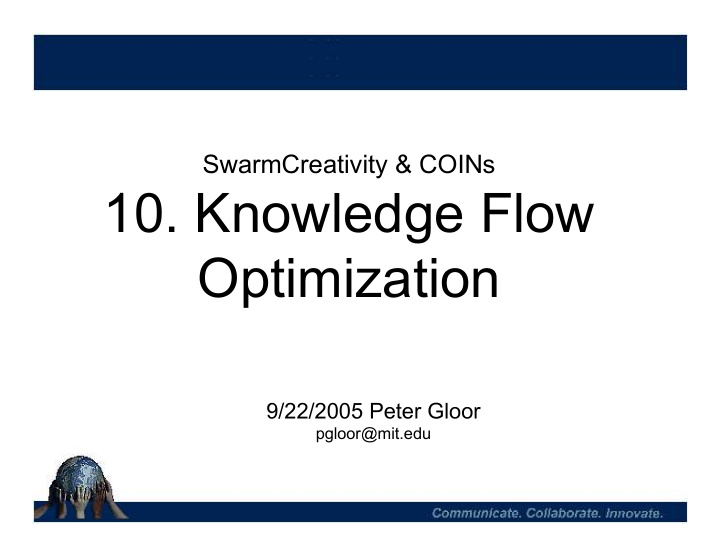



SwarmCreativity & COINs 10. Knowledge Flow Optimization 9/22/2005 Peter Gloor pgloor@mit.edu
Aligning process and organization by knowledge flow Communication flow Business process (Relationships) Org. structure Department Manager + + Team 1 Team 2 Pool Services Services connectivity interactivity sharing has competency reports to role belongs to BU is substitute of has
1.Visualize Knowledge Flow 2.Find COINs COIN Knowledge Members high (m-m) COIN Collaborative Innovation Network Degree of (1-m) community Connectivity CLN Degree of Flow Collaborative Learning Network Sharing small CIN personal (1-1) Collaborative Interest Network low high Degree of Interactivity Optimization 3.Redesign & (KFO) meritocracy transparency organization Optimize consistency swarm code of trust intelligence ethics relationship team creative ethical knowledge intelligence conscience sharing individual innovation collaboration communication 4.Monitor
1. Visualize Knowledge Flow • Convert Outlook to Eudora (converter.exe) • Spider online mailinglists (online.jar) • Collect Weblogs • Load Excel spreadsheets (Fileloader.jar) • Load *.mbx files (TeCFlow.jar)
TeCFlow Tips • Get files TeCFlow.bat, TeCFlow.jar, fr.dll into same folder in Windows • Log into MySQL database (using new name creates new database) • If not enough access rights in MySQL: From a command window call “mysql” and enter: grant all on *.* to ""@localhost • Can parse single*.mbx files and entire directories • Can parse with/without subject line, contents • Use MySQL Control Center tool MySQLCC to inspect, change database tables
TeCFlow database structure
TeCFlow Scalability • 500-1000 actors • 2000-10000 messages (links,ties) Four ways of scaling down: 1. “Want to set time constraints” (uses less memory) 2. Merge addresses (uses less memory) 3. Reduce communication frequency 4. Run without history • Reducing number of actors saves most memory
Delete mailing list addresses
Edges per keyframe
2. Discover COINs with history without history
Discover COIN/CLN/CIN
Find COIN Benchmarks • Financial results • Ask experts for rating • Use speed of innovation diffusion, innovation acceptance, SNA measures
3. Redesign & Optimize (1) Establish Swarm Creativity – Give up central control! (2) Fill the critical roles of innovator, communicator, and collaborator! (3) Establish distributed trust! (4) Establish a common code of ethics! (5) Establish a small world structure of high connectivity, interactivity, and knowledge sharing! (6) Set up a Collaborative Web Workplace! (7) Know when to change the organizational structure!
3.1 Establish Swarm Creativity – Give up central control • Find structural holes • Find gatekeepers • Find centers (influentials) • Create “democratic structure” of generally high betwenness • “Creative chaos” (changes in GBC) compared to “high-performance continuity”
3.2 Fill the roles of innovator, communicator, collaborator • Contribution index plot identifies • Coordinators • Creators/Innovators • Communicators/Ambassadors • Collaborators/Knowledge Experts • Dynamic view movie identifies centers/gatekeepers etc. and shortages
3.3 Establish distributed trust • Identify “hubs” for each subteam • Re-enforce “hubs” if needed • Search for “creative chaos” oscillating GBC • Recommend supporting trust-building steps if needed: • Connect hubs of “trust” • Initiate f2f interaction
3.4 Establish a common code of ethics • Meritocracy (identify coordinator, creator, communicator, collaborator) • Transparency (through TeCFLow) • Knowledge Sharing (contribution index) • Consistency - establish shared goals • Respect for individual • Reward system (Heisenberg & Hawthorne effect)
3.5 Establish a small world structure • Find structural holes • Find gatekeepers • Find centers (influentials) • Create “democratic structure” of generally high betwenness • “Creative chaos” (changes in GBC) compared to “high-performance continuity”
3.6 Set up a Collaborative Web Workplace highly personalized globally accessible collaborative high bulletin board virtual meeting workspace (m-m) (Webconference) Degree of (1-m) community mailing list Webcast Connectivity Degree of Sharing small e-mail chat personal (1-1) low high Degree of Interactivity
3.7 Know when to change organizational structure • Emphasis on “creativity” or “performance” • Emphasis on “self-organizing” or “hierarchical” • Rewarding “swarm creativity” (measure it first)
KFO Application Areas • Research and Development/New Product Development – Spot innovations • Sales Force – Communication sales rep - customer • Project Management – Knowledge flow in project • Mergers & acquisitions – Link hubs of trust
Privacy is a primary concern • Buy-in of study population crucial • Identity of individuals has to be protected – Replace names by identifiers – Results only reported in anonymous form • Proper measures to safeguard data – Only anonymized data goes outside of company – Content is encrypted • Open & honest communication with users – Share results with study population
Recommend
More recommend